April 24, 2009
Air Date: April 24, 2009
FULL SHOW
SEGMENTS
Cap and Giveaway
View the page for this story
Emerging legislation on climate change could give trillions of dollars over time to polluting industries. The details of Congressmen Henry Waxman and Ed Markey's bill includes a cap and trade scheme that would limit greenhouse gas emissions but give away about half of the permits to pollute for free, instead of auctioning them off. Peter Barnes, a senior fellow with the Tomales Bay Institute, talks with host Jeff Young about what the bill could mean for consumers, industry, and the emissions reductions. (06:20)
Solar Power from Space
View the page for this story
California utility PG&E plans to start receiving renewable energy from space by 2016. A satellite will collect solar energy and beam it back to Earth where it will be used for electricity. John Mankins is a former manager of NASA's space solar power studies. He tells host Jeff Young that such a system could provide baseload solar energy, 24 hours a day. (05:45)
Defending the Mountains
/ Jeff YoungView the page for this story
Host Jeff Young visits coal country activist Maria Gunnoe, who's fighting to stop the mining practice known as mountaintop removal. Gunnoe just won the prestigious Goldman Prize, sometimes called the Green Nobel. But she fears she's losing the mountains, community and heritage she holds dear. (08:00)
Volcanic Lightning
/ Prachi PatelView the page for this story
Scientists have long been puzzled as to why when volcanoes erupt, they’re often accompanied by lightning. When Alaska’s Mount Redoubt began rumbling, researchers quickly moved to install sensors to track radio signals created by lightning flashes. As Spectrum Radio’s Prachi Patel reports, they’ve been surprised by some of the results. (05:00)
Volcano, Oil and Fish
View the page for this story
Chevron’s Drift River oil terminal is located downstream from the Mount Redoubt volcano and upstream from Cook Inlet, an important habitat for salmon and whales. Bob Shavelson, Executive Director of the Cook Inletkeeper, tells host Jeff Young authorities are not prepared to clean up a major oil spill in the region if an accident occurs. (05:00)
ECOtime
View the page for this story
It’s amazing what better lighting can do. The spring sun’s rising position in the sky gives those gray winter clouds a new silver lining in this installment of the ECOcalendar project’s Ecotime. (01:15)
Emerging Note on Science
/ Sandra LarsonView the page for this story
Indian farmers are using ancient tricks on a modern problem. By working with native forests instead of against them, these stewards have been able to preserve biodiversity without hurting their harvest. Sandra Larson reports. (02:00)
Remaking the Medina
/ Clark BoydView the page for this story
The medina, the old town of Marrakech, Morocco, was once known as “the garden city of North Africa.” Private homes had verdant courtyards; orchards, grapevines and trees filled the city streets. But as the population grew, the gardens made way for shops and houses. In 2002 Clark Boyd reported on efforts to bring back the gardens of the medina. Host Jeff Young checks in with ethno-botanist Gary Martin to see if the people of Medina are living the lush life. (11:50)
This week's EarthEar selection
listen /
download
Show Credits and Funders
Show Transcript
Host: Jeff Young
Guests: Peter Barnes, John Mankins, Gary Martin, Bob Shavelson
Reporters: Clark Boyd, Prachi Patel, Jeff Young
Science Note: Sandra Larson
[THEME]
YOUNG: From Public Radio International - this is Living on Earth.
[THEME]
YOUNG: I’m Jeff Young.
A coal country activist wins a major environmental award for her efforts to stop the destruction of Appalachia.
GUNNOE: In November of last year I sat and watched the sunset on that mountain for the last time ever. It’ll never happen again. Now the mountain has been blasted away. It’s been pushed into the valley.
YOUNG: How mountain people are coping with mountaintop removal mining.
Also, as congress tackles a climate change bill, some wonder who’ll get stuck paying the bill.
BARNES: The power of the utilities and other industries is very great and it’s going to take some courageous members of Congress who can stand up to those lobbies and act on behalf of middle class families.
YOUNG: And the mystery of volcanic lightning.
These stories - and more - this week on Living on Earth! Stick around.
[NEWSBREAK MUSIC: Boards Of Canada “Zoetrope” from “In A Beautiful Place Out In The Country” (Warp Records 2000)]
ANNOUNCER: Support for Living on Earth comes from the National Science Foundation and Stonyfield Farm.
[THEME]
Cap and Giveaway

Powerful polluters could be the biggest winners of legislation to address climate change.
YOUNG: From the Jennifer and Ted Stanley Studios in Somerville, Massachusetts - this is Living on Earth. I’m Jeff Young.
A powerful Congressional committee is at work on a piece of legislation that could profoundly change how we power our country. California Democrat Henry Waxman, who chairs the House Energy and commerce committee, is the bill's lead author. Waxman says it would cut greenhouse gases, boost renewable power and create jobs.
WAXMAN: Our economic future and clean energy are inextricably intertwined. The economy that grows the fastest in this century will be the one that makes the greatest investments in new energy technologies.
YOUNG: The bill's centerpiece is a cap and trade program—limiting the amount of carbon dioxide that can be emitted into the atmosphere, while setting up a system to trade emissions permits.
Those permits will be very valuable, but as it stands, Waxman's bill says nothing about how they should be allocated, whether given away or auctioned. Billions, perhaps trillions, of dollars could rest on such technical differences.
We've asked Peter Barnes for some help in understanding what’s at stake here. Barnes is an entrepreneur and author who’s written extensively on climate change policy.
Peter, what do we know about how industry will get these permits?
BARNES: The general understanding is that the bill is going to give about half of the pollution permits for free to utilities and other industries. And this is a big deal because we’re talking about trillions of dollars ultimately that is being allocated to private companies.
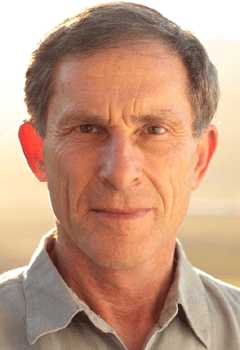
Peter Barnes (Photo: Timothy Archibald)
YOUNG: Now you said trillions. Not billions.
BARNES: That is correct. Over time, not on a one year basis, but over time the amount of money involved with these pollution permits is in the trillions of dollars. So this is a very big economic question involving who is going to pay and who is going to benefit. But there is more than one way to do a cap and trade system. Broadly speaking, you can have a cap and give away system where the permits or some percentage of them are given away free to polluting corporations. That’s one model. Another model is cap and dividend where the permits are auctioned and the money – the value of the permits – is returned to the people to protect families from the rising energy prices, which are going to result from capping carbon emissions.
YOUNG: Now clearly you prefer that we have a hundred percent auction and indeed that’s what President Obama was talking about early on. He even sent his budget man Peter Orzag up to the Hill to talk about the importance of a hundred percent auction. Why do you think we’re not hearing more from the White House now about the importance of a hundred percent auction?
BARNES: Well, I can’t really say. I think the White House is letting Congress do its thing. Unfortunately, the power of the utilities and other industries is very great and it’s gonna take some courageous members of Congress who can stand up to those lobbies and act on behalf of middle class families because if the utilities do have to pay more for coal, which they would, they will simply pass on their higher costs to the customer and the customer will be ultimately the one who pays.
YOUNG: However, I mean, can’t the utilities return some of this money to their rate payers and in, I don’t know, a form of rebates or any other way.
BARNES: They could, and that’s better than not returning it, but bear in mind that if they do give rebates, its going to be in proportion to energy use, and that’s not the right way to send a price signal.
YOUNG: You’re not really giving them a real strong incentive to conserve energy.
BARNES: That’s correct. If you give the money back on a per capita basis, so its not tied to your energy use, then people who use more energy, people who have big homes and lights and drive SUVs and so forth are gonna be paying more than people who use a little energy. And that’s the way it should be.

Powerful polluters could be the biggest winners of legislation to address climate change.
YOUNG: You know, though, I mean looking at the really tough political hardball game that they have to play if they want to get any kind of limit on greenhouse gas emissions passed – isn’t giving away some emissions just, you know, the price that we’re going to have to pay?
BARNES: Well it may be. But I think a case could be made that giving money back to the American people to offset the higher energy prices, we’re all going to face is actually politically, a better strategy than giving it to the large polluting corporation. If you do it this way, you’re building a broad popular constituency that will support the steadily declining cap on carbon and the corresponding increase in energy prices. You need that broad constituency because a carbon cap isn’t going to work over night. This is a thing that’s got to last and work for forty years. And if it doesn’t have popular support, we’re gonna hear cries of drill, baby, drill and let’s get back to the good old days of cheap energy. We don’t want that to happen.
YOUNG: If this bill proceeds along these lines where we have up to fifty percent, half of the credits given away in the early years, what do you think that’s going to mean? Do you think its going to be effective policy, not just in terms of who does or doesn’t pay money, but is it going to be effective policy in terms of bringing emissions down.
BARNES: Well we will, I hope, see some emission reductions. But the point here is that from an environmental standpoint, we actually want to have a price signal. Yes energy is going to cost more, but the way to protect consumers is not to eliminate the price signals. The way to protect consumers is to give them money back after they have faced the price signal. It’s the price signal that we need to get everybody to conserve, to innovate, to invest in new clean technologies, and the more we avoid giving this price signal, the longer its going to take to actually reduce emissions.
YOUNG: Peter Barnes is a senior fellow at the Tomales Bay Institute and author of the new book "Capitalism 3.0: A Guide to Reclaiming the Commons."
Related links:
- Click here to learn more about the Waxman/Markey bill
- Read Peter Barnes’ comparison of cap and trade approaches
Solar Power from Space
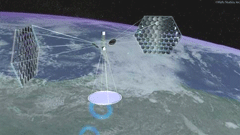
The proposed satellite would be about half a mile wide and create a beam of energy four miles wide by the time it reaches the earth. (Courtesy of: Engadget)
YOUNG: Well, the climate change bill before Congress aims to push renewable energy sources to new heights.
Here’s a project that takes that concept quite literally. California energy utility PG&E has contracted with the private company Solaren to put solar panels in space—and beam the power back to earth. Solaren hopes to start commercial operation by 2016, pulling 200 megawatts from orbit—that’s about half what an average coal fired power plant generates.
John Mankins managed NASA’s space solar power studies before starting his own company, Managed Energy Technologies. Mankins says a solar satellite is no small undertaking.
MANKINS: It’s about a half a mile across for the transmitter and it’s on the order of ten thousand tons or approximately twenty international space stations. It would collect the sunlight and convert it into electromagnetic radiation into a beam of energy and then send it to some other locations such as a receiver on the earth.
YOUNG: Now I’m envisioning this giant laser beam of concentrated solar power shooting down to the planet, but that’s not quite right.
MANKINS: [laughing] Hopefully, no one would ever actually build such a system. The beam when it’s up in space would start out at about a half a mile across and then it would spread and be on the ground – and again everything depends on the details of the engineering – but it would spread to be approximately four miles across. You’d certainly want to take the right precautions, keep the energy density, the amount of power that’s in a square meter of the beam low enough to be safe. You’d want to geographically isolate the receiver so it wasn’t in a populated area. And you’d want to have safe guards so that planes would, for example, not be allowed normally to fly through the beam and in the event that one did inadvertently or deliberately try to fly through the beam, you’d have to be able to cut it off in a timely way so that – a sort of belt and suspenders and buttons approach - so that it was safe to start with, it’s remote, and you turn it off just in case.

John Mankins is co-founder and chief operating officer of Manged Energy Technologies and former manager of NASA’s space solar power studies and
technology research and development. (Courtesy of NASA)
YOUNG: And then, what’s the collection system like? How do you get the energy on the surface of the planet?
MANKINS: Very, very elegantly. There’s basically a simple antenna with a diode in the middle of it, and it takes incoming radio waves and converts it at very, very high efficiency, maybe 80% or 85% efficiency into voltage. Mechanically, it would look a great deal like chicken wire, like a mesh, and so even though you had this large antenna collecting energy from the solar power satellite above you, below the ground itself would still receive something like 80 percent of normal sunlight, the rain would pass though, it would not have any kind of significant impact on the sort of the ecosystem, whether it was farms or natural land beneath it.
YOUNG: So, the solar power is collected on these satellites, which is orbiting, and obviously the solar energy up there is much stronger than it is here on earth, right?
MANKINS: So up in space the average sunlight passing the earth from the sun is about 1,400 watts per square meter. And on the earth at mid summer, mid day in the desert, it’s about 1,000 watts per square meter. And on the earth, of course, you add the additional factors of normal atmospheric absorption, you add weather, you add nighttime and the overall average sunlight which is available per square meter up in space is significantly greater than that which could ever be collected on the earth.

The proposed satellite would be about half a mile wide and create a beam of
energy four miles wide by the time it reaches the earth. (Courtesy of: Engadget)
YOUNG: Now, wouldn’t the satellite also be in the shadow of the earth at some point or can you position it so that it gets sunlight all the time?
MANKINS: A lot of different cases have been looked at. The one that looks the most promising is to place these solar power satellites in what’s called a geostationary earth orbit – that’s the same orbit that used for example by broadcast satellite radio or by broadcast TV satellites. Its high above the earth, about twenty three thousand miles up, and it has an usual property - that the time it takes for a satellite to go around the earth at this particular distance is just at 24 hours. If you use the right kind of transmission technologies, this is basically solid state arrays, you could deliver power from one satellite to New York in the morning to Dallas at midday and to Los Angeles in the afternoon.
YOUNG: Is it going to be worth the investment, though?
MANKINS: If you can solve the engineering problems, if you can get solar energy from space, for on the order of ten cents a kilowatt-hour, which is highly competitive with terrestrial energy sources, space solar power has the potential to provide absolutely carbon neutral energy to billions of people 24/7. So those would be problems definitely worth addressing.
YOUNG: John Mankins is an expert in space based solar power. He’s with Managed Energy Technologies. Thank you very much for speaking with us.
MANKINS: It’s been my pleasure. Thank you.
Related links:
- Pacific Gas and Electric
- Managed Energy Technologies
[MUSIC: Various Artists/Michael Franti “Stay Human (Stereo Steambath Remix) from Six Degrees Traveler 02 (Six Degrees Records 2002)]
YOUNG: Just ahead – A coal mining activist wins a major prize, but loses her beloved mountains. Keep listening to Living on Earth!
[CUTAWAY MUSIC: Allen Toussaint “Blue Drag” from The Bright Mississippi (Nonesuch 2009)]
Defending the Mountains
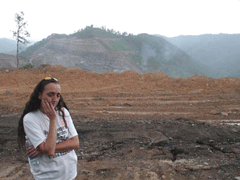
Maria contemplates the ongoing demise of Kayford Mountain, West Virginia. (Photo: Vivian Stockman)
YOUNG: It’s Living on Earth, I’m Jeff Young.
Each year the prestigious Goldman Environmental Prize, sometimes called the "Green Nobel," goes to just six people on this planet: one on each inhabited continent. They're singled out for taking a stand and making a difference on major environmental threats.
This year-- the 20th year for the Goldman prize--the North American winner is Maria Gunnoe, from the heart of coal mining country in West Virginia. Gunnoe's fighting to stop the mining practice known as mountain top removal, even as she and her family cope with life next to one of the giant coal operations.
[TRAIN CROSSING HIGHWAY] YOUNG: Gunnoe lives in Boone County, West Virginia, where coal trains and narrow roads twist through sharp valleys. Modest homes compete for the few flat patches along the road, rails and river. And most of the hills bear the marks of the region's main industry: coal.
GUNNOE: You can look to the east, west, and to the south of my house and you have mountain top removal sites. In just about every direction I look from my home that’s what I see now. YOUNG: Gunnoe's a 40-year-old mother of two. She's lean and angular with long, dark hair and a tomboy's gait. In a light April rain, she shows me around the land where her family has lived for generations.
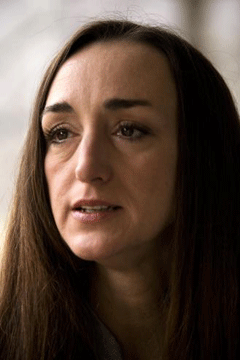
Maria Gunnoe (Photo: Antrim Caskey, Courtesy of Goldman Environmental Prize)
GUNNOE: My father and my grandfather prepared this place throughout the years to sustain us, to feed us basically. There’s black walnut here, white walnut. We have peach trees. This used to be an orchard until the flood took place and it tore a lot of trees out of the ground.
[SOUND OF STREAM]
YOUNG: The flood was a watershed event in her life. In 2003 this small stream on her property became a rushing torrent, filing the hollow from hillside to hillside.
GUNNOE: There was acres of my land that washed by me and my family while we sat on our front porch. I mean, it was terrifying, it really was.
YOUNG: Of course, floods happen in this part of the country – you’ve got steep hills and you get quite a bit of rain. But you don't think this was just a natural flood?
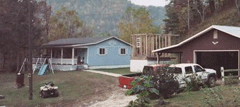
Before the flooding. (Courtesy of Maria Gunnoe)
GUNNOE: No I absolutely don’t. This wasn’t a natural flood – it was a manmade flood. What happened in 2000, there was a mountain top removal site moved into my backyard. And they ripped off about 400 ft of peak of the mountain that was adjacent to my property. They took the trees off and they took bulldozers and pushed what they call the overburden over into the valley behind me and created a valley fill. And when they started blasting, they put everything other than the coal into this valley fill. And just through the manipulation of the headwaters of this stream, what it’s done is created sort of like a paved parking lot, if you will. It's nothing but rock in the valley behind me, now, where it used to be mountains.
YOUNG: Across coal country residents say the flash flooding after mountain top removal was far worse than anything in memory.

After the flooding. (Courtesy of Maria Gunnoe)
Gunnoe decided to fight back by organizing. She works with local groups to press government officials for better regulation and enforcement. She's joined numerous lawsuits against coal companies, even in the face of harassment and intimidation. And she helps neighbors keep track of the mining and its damages.
[SOUND OF TRUCK DOOR OPENING]
YOUNG: We climb into Gunnoe's pickup for a driving tour of a nearby community called Twilight.
[TRUCK SOUNDS]
GUNNOE: In November of last year I sat and watched the sunset on that mountain for the last time ever. It'll never happen again. Now the mountain has been blasted away, it's been pushed into the valley.
YOUNG: A federal government assessment estimates more than a thousand miles of streams in Appalachia have been buried or polluted by valley fills. And some 800 square miles of mountaintop are now gone. Gunnoe fears the community here could soon be gone, too.

Maria contemplates the ongoing demise of Kayford Mountain, West Virginia. (Photo: Vivian Stockman)
[TRUCK DOOR OPENS, DOG BARKS, DOOR SHUTS]
YOUNG: We stop for a visit with Lora Webb, who lives with her husband and daughter just a few hundred yards from the entrance to a mountaintop removal site. Others around her are already moving, either lured by buyout offers from the coal company or just tired of the noise and dust from blasting and massive earth moving equipment. Webb wants to stay. But she's not sure she can if it means living next to the mine.
WEBB: Well, I've got bad neighbors [Laughs]. They do a lot of things that wouldn't be put up with anywhere else. From a regular person’s viewpoint, you can’t really see the extent of the damage, unless you’re in the air, and then it looks like Hiroshima, like a bomb went off.
YOUNG: What do you think's going to happen here? What do you think is gonna happen to your place and what do you think is going to happen to this whole community, Twilight?
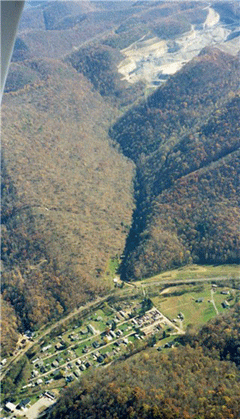
(Courtesy of Maria Gunnoe)
WEBB: I think if king coal has his way about it, I think it'll be gone, it won't exist anymore. You know, what kind of treatment is that to citizens of a community that's supplying the rest of America with power? And nobody to help em. What are they gonna do? They're gonna lose everything they've got - that's what’s gonna happen. That’s what I feel like is happening to us right now. Like it's just sand running through your fingers [Cries]. [
DOOR OPENS]
GUNNOE AND WEBB: Ok, be good. Thanks, see ya.
[TRUCK SOUNDS]
GUNNOE: It's a hell of a way to live.
YOUNG: Back in the truck, Gunnoe points out other homes where people have sold or just moved on. This community's name has never been more apt: it is in the twilight of existence.
GUNNOE: It's honestly some of the most giving, loving people you will ever meet in your life. And if you'll look, the houses are being torn down.
YOUNG: Oh yeah that's gutted out
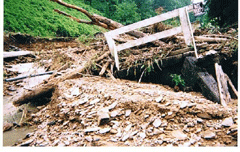
(Courtesy of Maria Gunnoe)
GUNNOE: That's the home of one of the elders that recently passed away. The coal company got what they wanted.
YOUNG: Here's another one.
GUNNOE: Yeah, the houses are being demolished. The coal companies have no uses for those houses. They don't intend for on people being here.
[YARD AMBIENT SOUND]
YOUNG: More than a decade of lobbying and lawsuits, demonstrations and protests have not slowed mountaintop removal. But recent action by the Obama administration could signal a change.
The Environmental Protection Agency is now reviewing mining permits focusing on the valley fills and their effects on water quality. It's not yet clear what the review will mean. But for Gunnoe, it seems like a lifeline of hope. Some of the permits under review are for mines on hills surrounding her house.
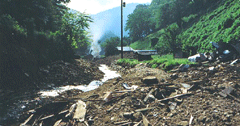
(Courtesy of Maria Gunnoe)
GUNNOE: With the new administration I have a sense of hope that I have not had in many years here. And it's because of the fact that we’re being heard in DC. I think we’ve cried loud enough and long enough that we should have been heard long ago. Now there's someone in office who cares about people. I really believe it's going to change.
YOUNG: Do you get sense it’s now or never?
GUNNOE: Absolutely I do. In some cases, for some communities, it’s already too late. But there’s other communities that’s just barely hanging on. And the decisions being made in Washington DC seals the fate of those communities.
YOUNG: With all that's going on, is it worth it to stay here?
GUNNOE: Absolutely. This is where I belong, this is where our memories lay at, this is
where my family lays for God's sake. I'm not leaving. I'm here for the long haul and I will stand here as evidence of what these coal industry’s put these people through. This is where I live, this is where I die, this is where I'll be after I'm dead and gone.
YOUNG: Maria Gunnoe, winner of the 2009 Goldman Environmental Prize.
Related links:
- More about Maria Gunnoe and the group she works with, Ohio Valley Environmental Coalition
- EPA's environmental assessment of mountaintop removal
- Discussion of the Obama administration's recent action on mining permits
[MUSIC: Andrew Bird “Anonimal” from Noble Beast (Wegawam Music 2009)]
[SOUNDS OF ERUPTIONS AND LAVA FLOW]
Volcanic Lightning
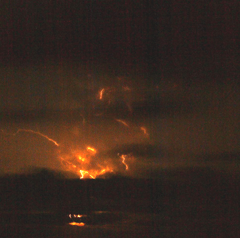
Mount Redoubt lightning. (Credit: Bretwood Higman)
YOUNG: Vesuvius, Krakatoa, Mt. Saint Helens - these volcanoes have caused massive devastation. And they have one more thing in common - their eruptions produced stunning displays of lightning. No one understands exactly why – so a team of researchers in New Mexico has been investigating.
And as Spectrum’s Prachi Patel discovered, the eruption of Alaska’s Mount Redoubt in late March was just the chance they’d been waiting for.
PATEL: Mount Redoubt rises over ten thousand feet in Lake Clark National Park, some 100 miles southwest of Anchorage. It began rumbling in January. But Steve McNutt, a scientist at the Alaska Volcano Observatory, had his eyes on Redoubt since November 2008, when it first started spitting heat and gas.
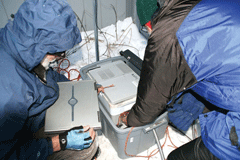
New Mexico Tech Professors Ronald Thomas (R) and Paul Krehbiel set up lightning sensors in Kenai, Alaska across Cook Inlet from Mt. Redoubt.
(Sonja Behnke/New Mexico Tech)
PATEL: Those four instruments are lightning sensors. Researchers at the New Mexico Institute of Mining and Technology developed them in 1997 to study thunderstorm lightning. Three years ago, they switched gears, packed the sensors in modified picnic coolers and set off to stalk volcanoes.
Redoubt is the third one they’ve studied. But it’s the very first time they had the instruments installed before a volcano blew its top. The sensors pick up radio frequency signals created by flashes of lightning.

Mount Redoubt lightning. (Bretwood Higman)
[SOUND OF POPPING RADIO IMPULSES]
PATEL: These radio signal recorded during the Mount Redoubt eruption let the researchers peek inside a volcano’s ash cloud. To do that, the sensor stations have to be set up at different distances from the volcano. Ronald Thomas is an electrical engineering and atmospheric physics professor at New Mexico Tech.
THOMAS: The lightning signals arrive at the closest station first and then the next closest station after that and so on arriving at the farthest station last. And then by putting that back together you can tell where the lighting came from.
PATEL: That is, you can locate exactly where the electrical discharge happened inside the volcano’s ash cloud.
THOMAS: And that way it gives us a nice picture of the lightning. Actually there’s thousands of impulses from each lightning so we get a whole just like a photograph of the lightning except it’s inside the cloud.
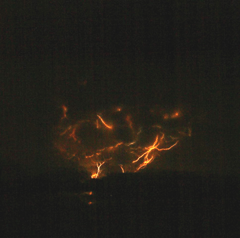
Mount Redoubt lightning. (Bretwood Higman)
PATEL: The three-dimensional picture shows where the electrical charges are in the cloud. And that, Thomas hopes, might reveal why some eruptions have a charge in the first place.
The findings could answer a few questions about how life started on earth. Some scientists believe that volcanic lightning might’ve been the true spark of life, converting a soup of water, ammonia, and methane into the building blocks of proteins. But the researchers’ work isn’t just about scientific curiosity. Their hope is that the lightning sensors could lead to an early warning system for eruptions.
At the National Severe Storms Laboratory in Norman, Oklahoma, researchers are studying thunderstorm lightning. Don MacGorman is a physicist at the laboratory.
MACGORMAN: We’re trying to understand how we can use lightning data to help us forecast and warn of weather hazards more accurately and in a more timely way.
PATEL: MacGorman uses the sensor system that the New Mexico researchers made. He’s been using it since 1998. He says the surprises come often.
MACGORMAN: We’re seeing things that we never suspected were occurring in a thunderstorm. We’re seeing for example that the very tip-tops of some very severe storms, the part of the cloud that goes up above into the stratosphere actually does have some little lightning flashes for want of a better word but they’re little sparks it looks like.
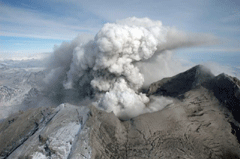
Mt. Redoubt erupts! (Game McGimsey, Alaska Volcano Observatory/USGS)
PATEL: NASA and the National Weather Service also use the sensors to track storm lightning. But the New Mexican researchers are the only ones studying lightning at volcanoes. Until they started doing that, scientists had thought the two types of lightning were similar. Just as charge created inside a storm cloud triggers lightning, charge created in a volcano’s ash cloud was thought to create flashes. But researcher Ronald Thomas says there might be more to volcanoes.
THOMAS: In the volcanic eruption we see lightning almost immediately as it starts to erupt and that tells us that the particles are coming out of the volcano charged.
PATEL: That’s not what Thomas was expecting.
THOMAS: The lightning we see just as the volcano erupts almost certainly has to be formed inside the volcano.
PATEL: Thomas doesn’t know why this happens, but he says they hope to find out at Redoubt. The volcano began erupting in March and has been generous.
THOMAS: So far we’ve gotten over 20 eruptions with lightning with all the big eruptions, in all the big eruptions. We’re just getting lots and lots of data and a lot more than we expected or lot more than we’d hoped for. It’s really amazing.
PATEL: The explosion of research riches is likely to keep them busy for months and perhaps years to come. For Living on Earth, I’m Prachi Patel.
YOUNG: Our report on volcanic lightning comes to us courtesy of Spectrum Radio, the broadcast edition of IEEE Spectrum, the magazine of technology insiders.
Related links:
- IEEE Spectrum story on volcanic lightning by Prachi Patel
- Ronald Thomas' homepage
- Alaska Volcano Observatory
Volcano, Oil and Fish
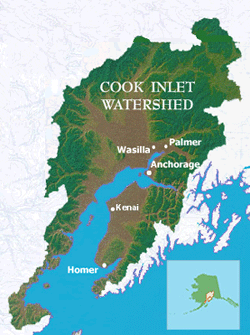
Cook Inlet (Courtesy of Cook Inletkeeper)
YOUNG: Though its eruptions have subsided, Alaska’s Mount Redoubt continues to spew volcanic gasses and ash. That has some locals worried – because below the volcano is Cook Inlet, and a Chevron oil storage facility.
Bob Shavelson is the Executive Director of Cook Inletkeeper, a non-profit organization dedicated to protecting the Inlet and its watershed. He joins me from a studio in Homer, Alaska.
Mr. Shavelson, welcome to Living on Earth.
SHAVELSON: Thank you, Jeff. My pleasure to be here.
YOUNG: Now, give us a feel for the lay of the land here. We have this volcano, which is quite active. About how far from the volcano to this oil facility?
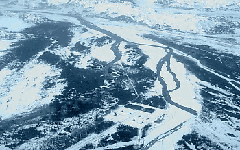
The dark pathways of a lahar move past the Drift River Oil Facility pictured here as the whit rectangles in the middle of the photo. This photo is from 1990, Mt. Redoubt erupts approximately every 20 years.
SHAVELSON: Well, its approximately seventeen miles from the oil tank farm that’s operated by Chevron to the peak of Mount Redoubt, but the tank farm sits in the drift river valley which provides a conduit up to the volcano, so when you get the pyroclastic flows from the eruption, they produce these lahars which the mud and debris and water and ice flows that come down. They’ve been described by experts as moving walls of cement.
YOUNG: I guess you’re putting two and two together here and thinking boy, if that hits the oil facility, that’s a bad situation.
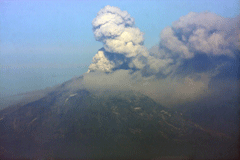
Since March 22, 2009 Mt Redoubt has erupted at least 19 times. (Photo: Thomas Kerns, Courtesy of NASA)
SHAVELSON: Absolutely. You know Cook Inlet sits in the Pacific Ring of Fire, we’ve got five active volcanoes in our area. We’re also the oldest oil and gas producing region in the state. So, its not like these situations haven’t arisen before. In fact, in 1989 and ’90, we had the exact same scenario where and eruption of Mount Redoubt threatened this very same terminal and posed a significant threat to the fisheries and the people they support in Cook Inlet.
YOUNG: And tell me more about Cook Inlet. Why is the water there so important?
SHAVELSON: Cook Inlet supports all five species of wild Pacific salmon and the salmon and halibut fisheries here support countless Alaskans. It’s very important for the economy here.
YOUNG: Do we know why Chevron put the facility there in the first place? It seems, you know, if you knew the nature of volcanoes, you wouldn’t want to be right there.

Cook Inlet (Courtesy of Cook Inletkeeper)
SHAVELSON: [Laughs] That’s an excellent question. I’ve heard it probably hundreds of times in the past couple weeks. The facility was sited in the 1960s. And, you know, this was before a lot of our major environmental legislation, the Clean Air Act, the Clean Water Act had been installed and there was a different mindset then. From what I understand, it was simple geography. They wanted access to deeper water and they also wanted to be out of the heavy ice and tide conditions that you find further north in the inlet.
YOUNG: And how much oil are we talking about? How much oil is kept in those big tanks?
SHAVELSON: It fluctuates, and one of the problems that we have with this situation was that prior to the eruption on March 22nd, we weren’t able to find out how much oil was in the tanks. In fact, Chevron refused to reveal it and they cited the Homeland Security Act. And they also refused to reveal something called a volcano readiness plan that presumably would have told how they were going to deal with the catastrophic spill from this facility, but then on March 22nd when the volcano erupted, a press release went out and we learned finally that there was 6.3 million gallons of oil sitting at the base of the volcano. Just about half of the volume of oil that spilled with the Exxon Valdez
YOUNG: And if there were and accident of this nature, how would they deal with an oil spill?
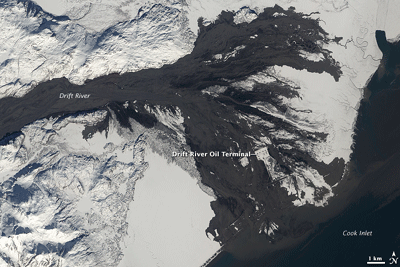
The recent eruption of Mt. Redoubt sent a volcanic avalanche, or lahar, downstream to the Drift River Valley where a Chevron oil storage facility is
located. (Courtesy of NASA)
SHAVELSON: Well, that’s a really good question, because from our perspective there’s no technology that would be suitable to address a spill in this scenario. We already know that it’s virtually impossible to clean up oil and ice. When you think about a lahar induced oil spill where you would have mud and debris and ice and these things pushing these oil tanks and all the oil in them out, we don’t have the technology, the spill removal technology, to address those things.
YOUNG: What do you look to as a more permanent solution here?
SHAVELSON: We would prefer to see a pipeline that would reduce the risk of shipping the oil.
YOUNG: Now, I guess if I were Chevron, responding to this, I would say, look, we’ve been here forty years. And we haven’t had an accident. Therefore that proves we’re safe. How do you respond to that?

Location of Redoubt volcano, in relationship to surrounding towns, roads, and other volcanoes. (Image: Janet Schaefer, Courtesy of the Alaska Volcano Observatory / Alaska Division of Geological & Geophysical Surveys)
SHAVELSON: Well, that’s what we heard from the oil industry prior to Exxon Valdez. And one of the lesson we learned from the Exxon Valdez is that you can’t be complacent. You have to plan, you have to have the resources available to address these contingencies that we know that are there. The 1989-1990 eruption of Mount Redoubt showed very clearly the risk posed by this scenario. Yet we did literally nothing to address them, so we’ve had a repeat situation here in 2009.
YOUNG: Bob Shavelson is executive director of the Cook Inletkeeper, and he’s been talking to us about volcanoes, oil and water and why he hopes they never mix, right?
SHAVELSON: And fisheries.
YOUNG: And fisheries.
[LAUGHING]
YOUNG: Thanks very much for your time – I appreciate it.
SHAVELSON: Thank you, Jeff. My pleasure.
YOUNG: Now we contacted Chevron - they sent a statement. It reads - in part:
“Chevron will determine if there is a safe and economically viable method for shipment of crude oil from the Cook Inlet operations to market without relying on the storage tanks located at the Drift River Terminal.”
Related links:
- Cook Inletkeeper
- Alaska Volcano Observatory
- Chevron Home Page
[MUSIC: Jimi Hendrix “Land Of The New Rising Sun” from Voodoo Soup (MCA Records 1995)]
YOUNG: Just ahead – replanting the gardens of a medieval city. Stay with us - on Living on Earth.
ANNOUNCER: Support for the Environmental Health Desk at Living on Earth comes from the Cedar Tree Foundation. Support also comes from the Richard and Rhoda Goldman fund for coverage of population and the environment. And from Gilman Ordway for coverage of conservation and environmental change. This is Living on Earth on PRI, Public Radio International.
[CUTAWAY MUSIC: Dave Douglas “Flood Plain” from Moonshine (Koch records 2008)]
ECOtime
YOUNG: It’s Living on Earth. I’m Jeff Young.
[ECOtime theme]
Around every dark cloud there’s – well, you know – a silver lining. And now that – at last - it really feels as if winter has past, the folks at the ECOcalendar project are looking to the heavens to capture cosmic moments – in this audio snapshot we call ECOtime.
HARDMAN: The Silver Lining. Winter clouds are often dark and brooding, and yet these same thick clouds are now traveling across the spring sky but they seem less foreboding. It may be because spring is here and these clouds won't be delivering snow and sleet anymore. But maybe it's also because of how they're lit. All winter long the sun's been traveling along the southern horizon, lighting the clouds from the side. But the sun has been steadily moving higher into the sky and is now above them. So now, these same dark clouds have silver linings because they're backlit. The sun is lighting up their edges, and whenever there's a break between the clouds a shaft of sunlight descends.
YOUNG: That's Chris Hardman with ECOtime, part of the ECOcalendar project. For more, check our website loe.org.
[MUSIC: Music provided by the ECOtime Project]
Coming up – regreening the heart of an ancient city. But first – how an ancient system of agriculture may help preserve biodiversity - in this note on emerging science from Sandra Larson.
[MUSIC: Emerging Science Theme]
Emerging Note on Science
LARSON: Agriculture and biodiversity don’t always mix. When forests are cleared for crop planting, the diversity of the native species usually drops, and ecosystems are endangered. But a recent study brings encouraging news from an Indian palm plantation.
Researchers from Stanford University and in India studied bird populations near areca nut palm plantations in southwestern India. The nut from the palms is valued as a coffee-like stimulant.
The scientists discovered ninety percent of the bird species associated with the nearby native forest were found in and around the plantation. In other words, farming had not significantly affected the variety of birds.
Here’s why: The areca nut plantations use traditional agricultural methods of the region, including a complex system of intercropping. The farmers retain a mix of native vegetation and grow valuable crops such as pepper and vanilla between the areca nuts. And they integrate the nearby forest into their cultivation practices, including using leaves as mulch for crops. So the system is economical as well as environmentally friendly.
The findings, which appeared in the Proceedings of the National Academy of Science, give hope that well-managed harmonious farming methods could help conserve biodiversity in other tropical regions.
So one way to preserve species in the future is to take a lesson from an old system farmers in India have used for over 2000 years.
That’s this week’s emerging – or should we say ancient – science note. I’m Sandra Larson.
Remaking the Medina
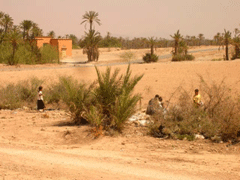
Children pick up trash in the Marrakech Palmery project. (Courtesy of Gary Martin)
YOUNG: We’ve been celebrating Earth Day for the entire month of April by checking out our archives, and checking in on developments in some memorable stories from past years.
Today we head back to 2002 – to the Moroccan city of Marrakech. Since it was founded in the year 1071, Marrakech has been an oasis at the edge of the Sahara, a place of rest and comfort for traders from across Africa and Europe. Traditionally the city's old town, known as the medina, was filled with gardens, full of vines and fruit trees. But in more recent years the population of Marrakech exploded, and houses replaced green spaces.
As Clark Boyd reported, a group of citizens banded together to re-green the medina of Marrakech.
[SOUND OF MUSIC AND VOICES]
BOYD: Walking through the Marrakech medina, it's hard to believe that this was once known as the "Garden City of North Africa." Every inch of the old part of the city looks like it's covered in concrete and asphalt, and all of it is constantly buzzing with human activity.
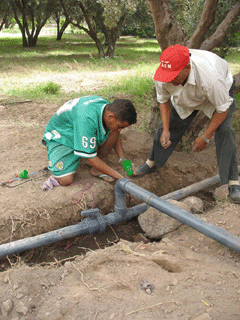
Working on the irrigation system. (Courtesy of Gary J. Martin)
[SOUND OF TRAFFIC]
BOYD: BMWs and horse carts jockey for position on the medina's narrow streets, while in the walkways through the markets, craftsmen busily prepare for the day's business.
[SOUND OF HAMMERING]
BOYD: Historically, a majority of the space inside the walls of the medina was devoted to what western city planners today would call "green space." Residents used the land to plant gardens, fruit orchards, and climbing vines. In the early 1900's, the medina supported a population of about 60,000 people. Now it's home to four times that many residents.
AL ALAWI: As you see, once we go through any of the gates, it really gets--
BOYD: Hicham Al Alawi is a tour guide and life long resident of the Marrakech medina. Alawi says that the population increase began when Moroccans started migrating to the cities a century ago.
AL ALAWI: A lot of people have immigrated from the countryside actually inside the medina because of the drought, because of the economic conditions that haven't been really at the ease of those people, and they were seeking of improving their ways of life.
BOYD: And as the population grew, the green spaces dwindled. In the inner courtyards at the medina's private homes, plants and trees were cut down to make space for shopkeepers. Vegetable gardens that once provided ample food for the people were dug under when new housing was built on the land. Even the sultan's impressive Royal Gardens, once the pride of all the medina's residents, were left to whither away to dirt as water resources were taken over by the burgeoning population. Residents like Mustafa, who makes clothing and who has been working in the medina since he was six, bemoan the loss.
[MUSTAFA SPEAKING ARABIC]
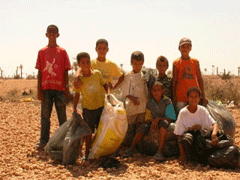
The children of Douar Abiad picked up 150 kg of plastic bags, earning 1,5 dirhams for each kilo. (Courtesy of Gary Martin)
MALE VOICEOVER: I remember when there was a huge, shadowy olive tree in the spice market. But they cut it down, because they needed the space. They didn't realize that after they cut it down, they'd have to stand in the hot sun all day.
BOYD: Marrakech natives aren't the only ones who've noticed the decline of the city's gardens. Gary Martin is an ethnobotanist who has lived in Marrakech for 15 years. He fears that the decline of the gardens is affecting the ecological balance of the Marrakech area.
MARTIN: It is the point of botanical diversity, a place of great floristic diversity in North Africa. It's the most diverse area in the Mediterranean basin if you exclude Turkey, and the biological diversity in terms of plant and animal species that you certainly find here, is clearly matched by the cultural diversity.

Children pick up trash in the Marrakech Palmery project. (Courtesy of Gary Martin)
BOYD: And so Martin decided to try to save the medina's green spaces. He started up a non-profit called the Global Diversity Foundation. With the goal of "re-greening" the Marrakech medina, Martin first turned to Mohammed El Faiz, author of two books on the gardens of Marrakech. El Faiz says that traditional Moroccan gardens weren't just pretty.
[EL FAIZ SPEAKING FRENCH]
MALE VOICEOVER: Sure these gardens were decorative, but they also helped the people by having vegetation: fruit trees, aromatic plants, medicinal plants. There was a functionality to the gardens.
BOYD: El Faiz's knowledge, along with input from residents, helped the Global Diversity Foundation's Gary Martin plan how best to bring back the medina's green spaces. The idea, says Martin, is to try to get people to use whatever space is left for greenery to refurbish the old royal gardens with plants, and to encourage homeowners to once again devote courtyard space to trees and vines.
MARTIN: Let's do re-greening with some of the historically resident species; the things that used to grow there, that grew there for centuries, things like carob trees, grape vines, olives, date palms. These are the things that we really associate with North African civilization in general, and particularly urban areas, and areas in the rural hinterland around cities. And these are the species that are really, if you could call it that, the North African suites of useful species.
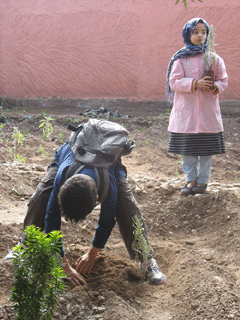
Children work in the Abi al Alaa al Miaari garden in the Marrakech medina. (Courtesy of Gary Martin)
BOYD: The municipality is working to insure that enough water flows into the medina so that all these efforts will succeed.
[SOUND OF BIRD CHIRPING, PEOPLE'S VOICES]
BOYD: In the wool market in the heart of the Marrakech medina a grape vine, or daliya, planted a year ago by the Global Diversity Foundation is now beginning to wind its way up a trellis. It's one of a number of small re-greening projects that are in the works here. The idea is to use small amounts of money to start the initial plantings, and then let the locals take over.
More than 400 women sell clothing here, and they fiercely guard and tend the vine, no one more so than 60-year-old Fatima.
[FATIMA SPEAKING ARABIC]
FEMALE VOICEOVER: I water it every evening when the temperature cools off. I also make sure the vine is fertilized, and that the weeds are removed. I tell all the other ladies here to do the same.
BOYD: Fatima and the others say that they can't wait until the summer when they'll be able to sit in the shade under the vine, sipping a cool drink.
[SNAKE CHARMER MUSIC]
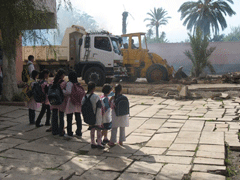
Children from Oum Salama watch construction of the garden. (Courtesy of Gary Martin)
BOYD: They also plan on divvying up the grapes that they grow amongst themselves, a throwback to the old days when the medina's green spaces were shared equally among all. For Living on Earth, this is Clark Boyd in Marrakech, Morocco.
YOUNG: We first aired that report on efforts to regreen the Medina of Marrakech back in 2002.
Global Diversity Foundation’s director, Gary Martin, has been listening in. He’s the ethnobotonist that we heard from in the story and he joins us by phone from Paris.
Mr. Martin, welcome back to the program.
MARTIN: Oh thanks. Thanks for having me back.
YOUNG: Well, how do the gardens of medina grow these days?
MARTIN: Well, actually there’s so pretty good news. One of the things that we did after that report was to focus particularly on working with school children and to do school gardens. We have created a garden, actually in 2003 at the Ibn Abi Sofra primary school. And that one’s going strong after six years. The kids are cultivating their own fruits and vegetables. They’re eating them in the school cafeteria. And that’s contributing to enriching school lunches for over 150 kids at that particular school.
YOUNG: What kind of feedback do you get from the residents who tend to or benefit from these gardens? Do you get a sense that they are invested in this, feel like stakeholders and wanna protect the gardens?
MARTIN: Yeah, definitely. I think that everybody is happy when they’re in the garden. And that’s probably even more true in a very arid zone, a zone of oases and where the only green space is our gardens. And for that reason, there’s quite a bit of popular support for this idea of bringing back to palm grove, bringing back to gardens in the city itself. And that’s, I would say, pretty much across the board, from people who are from Marrakech, who’ve grown up there or from the middle of the medina, out to the palm grove and the people who have recently moved there – of which there’s, in fact, quite a number of people from Europe and the United States that are starting to become established in Marrakech.
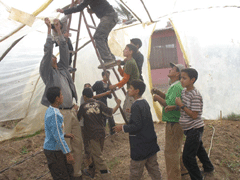
Raising the greenhouse. (Courtesy of Gary Martin)
YOUNG: What about the effort to restore the royal gardens, which I understand had just been allowed to kind of wither away?
MARTIN: Well, I have to say the royal gardens are not withering away – they’re part of the royal domain and that means its part of the royal family’s lands. And they’re being maintained. There hasn’t been a big effort to restore them and open them to the public. But on the other hand there’s something else that’s very exciting that’s going on that the royal family’s very involved in and that is bringing back the palm grove of Marrakech, what is called the palmery of Marrakech.
YOUNG: Tell me about that.
MARTIN: Well, that’s an interesting project because we talked about in the previous interview that Marrakech was founded in the eleventh century. At that time, a green belt was establish around the city, apart from the gardens and the middle of the walled city – there’s a palm grove that was created, and those were thousands and thousands of palm trees. And amongst the palm trees you had small villages, small dua’a, which were cultivating orchard gardens, fruits and vegetables that then they would take to sell in the city itself. Over time, and because of the drought that Marrakech experienced in 60s, 70s, 80s, 90s, up until the present – that palmery has started to deteriorate. But now since two years ago there’s a huge effort to bring it back, to do ecological restoration. And that’s included planting just over the last two years 217,000 date palm trees.
YOUNG: Now the city has not stopped growing. It’s still booming. How is that affecting the effort to keep some space and keep some water to allow for gardens?
MARTIN: Well, that’s a bit the down side. You’re absolutely right, there’s a massive building boom in Marrakech. It’s taking its toll on the very scarce water resources of the city. We had a little bit of a respite this year because we had the rainiest year since 1963. And when I left Marrakech this morning, it was a blooming city, the roses are in bloom, the pomegranates are in bloom, the carob fruits are on the trees. The olive trees are in flower. So it’s looking quite good this year. But the difficulty is, in fact, that with so much building going on, there’s a lot of ground water pumping and this is leading to quite a big impact on the scare water resources of Marrakech.
YOUNG: Now someone in the story mentioned the importance of shade, which I imagine is very important in that part of the world. Is there more shade now as a result of these efforts?
MARTIN: Well to some extent there is more shade. You certainly won’t find a forest if you come to Marrakech, but you will be finding additional palm trees from the palm grove, other trees growing around them, and a little bit more shade.
YOUNG: Are there benefits here as cities look to coping with climate change? And I’m guessing in a city like this, if the world’s gonna get warmer, things like this are of greater benefit, aren’t they?
MARTIN: Yes, they certainly are. This is – it’s a very interesting question because adapting to climate change, from my point of view, means reaching back into the traditions and the practices and the beliefs of the people who have bee interacting with the environment for a very long time. In this case the original inhabitants of the medina of Marrakech, of the palm groves of Marrakech – and that tradition, those traditions and beliefs and know how have been passed along in terms of how to take care of the Palm Grove, how to have an orchard garden, how to grow plants. I think these communities that are really living very closely with their environment, are the ones that are going to be leading the way in how to adapt to climate change. And, in fact, hopefully, how to mitigate climate change.
YOUNG: I thank you very much for your time. Gary Martin is an ethnobotanist with Global Diversity Foundation and he’s been giving an update on the effort to re-green the Medina of Marrakech. Mr. Martin, thanks very much.
MARTIN: Thank you.
[MUSIC: Various Artists/Argon Riffter “Dahwad Sunset” from Marrakech Medina (Goldensong Records 2008)]
YOUNG: On the next Living on Earth, the times they are a-changing’ – and today even the way we tell time is changing.
MAN: You think about it, most people under the age of 25 do not wear a wristwatch. They use their cell phone. And so, arguably, the wristwatch will go the same was as the pocket watch.
YOUNG: The Thousand Watch Project hopes to preserve the wristwatch for all time. Next time, on Living on Earth.
[BUBBLING AND RUMBLING SOUNDS OF RECORDED EARTH VIBRATIONS]
YOUNG: You wouldn’t necessarily know it, but the Earth is never still. The natural motion of the planet’s crust and mantle, and even larger quivers from earthquakes, are rarely audible to the human ear. But seismologist John Bullitt grabbed recordings of the Earth’s natural, low frequency vibrations, sped them up, and shifted the pitch, so the rumblings, earthquakes and burps of ocean waves can be heard. And they’re showcased on his CD, Earthsound.
[SOUNDS: John Bullitt “May – August 2006”]
YOUNG: Living on Earth is produced by the World Media Foundation. Our crew includes Bobby Bascomb, Eileen Bolinsky, Bruce Gellerman, Ingrid Lobet, Helen Palmer, Ike Sriskandarajah, and Mitra Taj, with help from Sarah Calkins and Marilyn Govoni. Our interns are Lindsay Breslau, Liz Gross, Phil DiMartino and Christine Parrish. Jeff Turton is our technical director. Alison Lirish Dean composed our themes. You can find us anytime at loe.org. Our executive producer is Steve Curwood
I’m Jeff Young - Thanks for listening.
ANNOUNCER: Funding for Living on Earth comes from the National Science Foundation, supporting coverage of emerging science, and Stonyfield Farm: organic yogurt and smoothies. Stonyfield pays its farmers not to use artificial growth hormones on their cows. Details at stonyfield.com.
Support also comes from you our listeners, the Ford Foundation, the Town Creek Foundation, and the Oak Foundation supporting coverage of climate change and marine issues; The Rockefeller Foundation and its Campaign for American Workers. More at rock found dot org. And Pax World Mutual Funds: socially and environmentally sustainable investing. Pax World: for tomorrow. On the web at paxworld.com.
ANNOUNCER: PRI, Public Radio International.
Living on Earth wants to hear from you!
Living on Earth
62 Calef Highway, Suite 212
Lee, NH 03861
Telephone: 617-287-4121
E-mail: comments@loe.org
Newsletter [Click here]
Donate to Living on Earth!
Living on Earth is an independent media program and relies entirely on contributions from listeners and institutions supporting public service. Please donate now to preserve an independent environmental voice.
NewsletterLiving on Earth offers a weekly delivery of the show's rundown to your mailbox. Sign up for our newsletter today!
 Sailors For The Sea: Be the change you want to sea.
Sailors For The Sea: Be the change you want to sea.
 The Grantham Foundation for the Protection of the Environment: Committed to protecting and improving the health of the global environment.
The Grantham Foundation for the Protection of the Environment: Committed to protecting and improving the health of the global environment.
 Contribute to Living on Earth and receive, as our gift to you, an archival print of one of Mark Seth Lender's extraordinary wildlife photographs. Follow the link to see Mark's current collection of photographs.
Contribute to Living on Earth and receive, as our gift to you, an archival print of one of Mark Seth Lender's extraordinary wildlife photographs. Follow the link to see Mark's current collection of photographs.
 Buy a signed copy of Mark Seth Lender's book Smeagull the Seagull & support Living on Earth
Buy a signed copy of Mark Seth Lender's book Smeagull the Seagull & support Living on Earth

